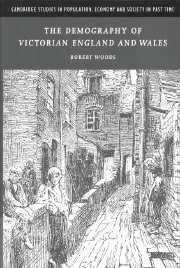Book contents
- Frontmatter
- Contents
- List of figures
- List of tables
- Preface
- 1 Bricks without straw, bones without flesh
- 2 Vital statistics
- 3 Whatever happened to the preventive check?
- 4 Family limitation
- 5 The laws of vitality
- 6 Mortality by occupation and social group
- 7 The origins of the secular decline of childhood mortality
- 8 Places and causes
- 9 The demographic consequences of urbanisation
- 10 The transformation of the English and other demographic regimes
- 11 Conclusions and unresolved conundrums
- Bibliography
- Index
- Cambridge Studies in Population, Economy and Society in Past Time
11 - Conclusions and unresolved conundrums
Published online by Cambridge University Press: 07 August 2009
- Frontmatter
- Contents
- List of figures
- List of tables
- Preface
- 1 Bricks without straw, bones without flesh
- 2 Vital statistics
- 3 Whatever happened to the preventive check?
- 4 Family limitation
- 5 The laws of vitality
- 6 Mortality by occupation and social group
- 7 The origins of the secular decline of childhood mortality
- 8 Places and causes
- 9 The demographic consequences of urbanisation
- 10 The transformation of the English and other demographic regimes
- 11 Conclusions and unresolved conundrums
- Bibliography
- Index
- Cambridge Studies in Population, Economy and Society in Past Time
Summary
In his preface to Eminent Victorians Lytton Strachey remarks that ‘The history of the Victorian Age will never be written: we know too much about it. For ignorance is the first requisite of the historian – ignorance, which simplifies and clarifies, which selects and omits.’ Victorian demography is a similarly vast topic with its own ocean of material; it too is likely to defy the comprehensive survey, the definitive statement. While Strachey's own approach has a certain poetic elegance, a sample of four individuals, even the inhabitants of four counties, would not have been sufficient for us to begin the task of reconstructing the pattern of demographic change during a period of sixty to seventy years in a population which grew from 16 to 36 million, although he is certainly correct about the need for simplification and selection. This concluding chapter is devoted, therefore, to the subject of ignorance and the ways in which it may be better appreciated and used constructively. It begins by considering three problematical areas where recently it has been thought that long-standing demographic conundrums are now resolved, or nearly so.
It still seems most likely that a relatively short-lived upswing in fertility rather than a sharp downturn in mortality was responsible for initiating the modern growth of population in England during the late eighteenth and early nineteenth centuries, and that fertility was responding mainly to a rise in nuptiality.
- Type
- Chapter
- Information
- The Demography of Victorian England and Wales , pp. 400 - 410Publisher: Cambridge University PressPrint publication year: 2000



